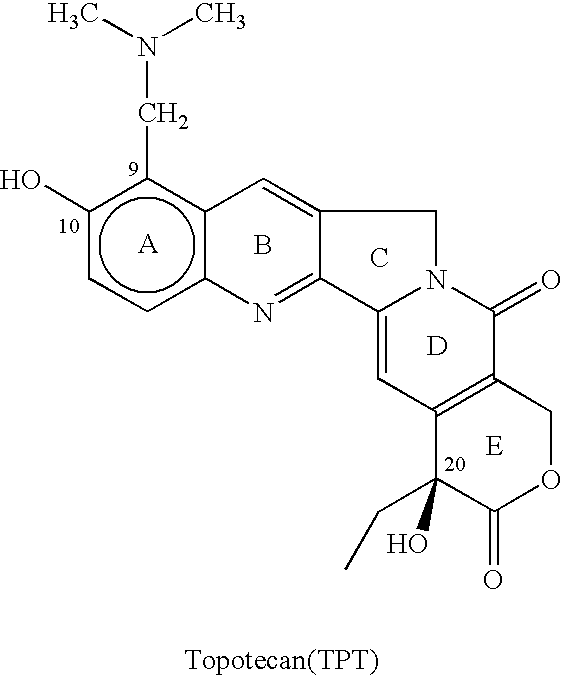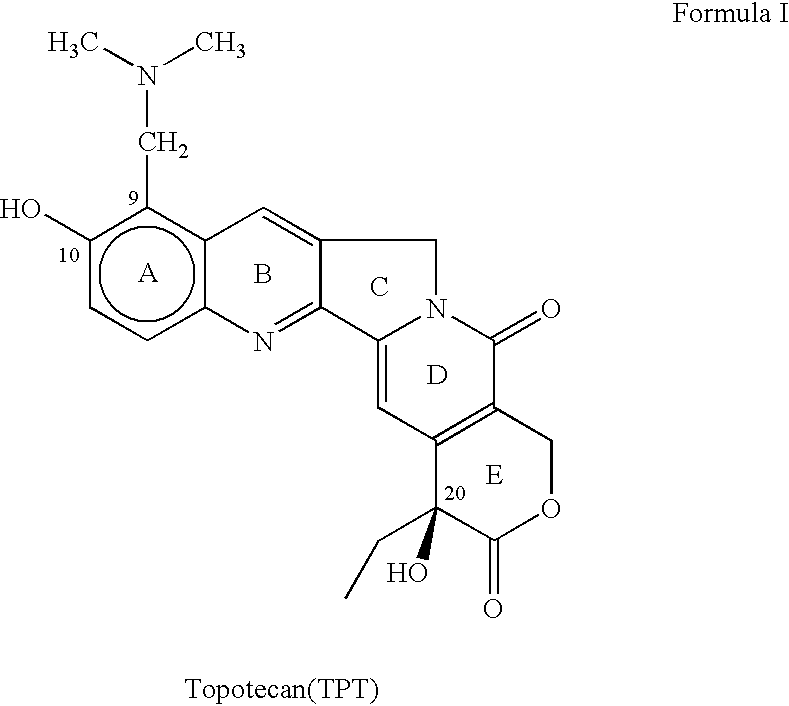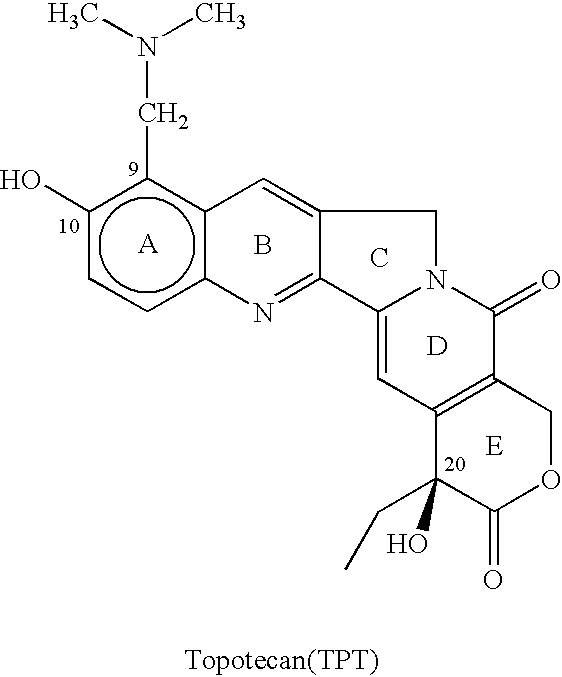Process for preparing Topotecan from 10-hydroxy-4-(S) camptothecin
a technology of topotecan and camptothecin, which is applied in the field of process for the preparation of topotecanhcl from 10hydroxy-4-(s) camptothecin, can solve the problems of limited water solubility, low yield, and inability to optimally use cpt, and achieves low density, high reactivity, and good yield
- Summary
- Abstract
- Description
- Claims
- Application Information
AI Technical Summary
Benefits of technology
Problems solved by technology
Method used
Image
Examples
example ii
HCPT (0.364 g 0.01 mmol) and 40% aqueous dimethylamine (12 ml) was added in dibromomethane (50 ml) in which anhydrous potassium carbonate (2.17 g 15 mmol) has been suspended. The reaction mixture was stirred at room temperature for 5 hour, then filtered and solid extracted wit ethylacetate (20 ml). The solvent is evaporated in vacuo giving a residue. The residue was triturated with 0.5% aq HCl (50 ml) to dissolve the water-soluble adduct. Water-soluble were partitioned with petroleum ether (3.times.50 ml) and followed by ethylacetate (3.times.50 ml). The aqueous layer was lyophilized as an off white hydrochloride salt yield 0.244 g (67%), C.sub.23 H.sub.23 N.sub.3 O.sub.5. (m / s. 421.44); IR (KBr) 3400, 2960, 1740, 1650, 1590 cm.sup.-1 ; .sup.1 H NMR (CDCl.sub.3) 1.04 (t, 3, J=7 Hz, C-18), 1.96 (q, 2, J=7 Hz, C-19), 2.01 (s, 3, CH.sub.3 CO.sub.2), 2.50 (s, 6, (CH.sub.3).sub.2 NH), 4.20 (s, 2, ArCH.sub.2 N), 5.28 (d, 1, J=19 Hz, C-17), 5.29 (s, 2, C-5), 5.50 (d, 1, J=10 Hz, C-17), 7.4...
example iii
HCPT (0.364 g 0.01 mmol) and 40% aqueous dimethylamine (12 ml) was added in dibromomethane (50 ml) in which anhydrous potassium carbonate (2.17 g 15 mmol) has been suspended. The reaction mixture was stirred at room temperature for 5 hour, then filtered and solid extracted wit ethylacetate (20 ml). The solvent is evaporated in vacuo giving a residue. The residue was triturated with 0.5% aq HCl (50 ml) to dissolve the water-soluble adduct. Water-soluble were partitioned with petroleum ether (3.times.50 ml) and followed by ethylacetate (3.times.50 ml). The aqueous layer was lyophilized as an off white hydrochloride salt yield 0.250 g (69%), C.sub.23 H.sub.23 N.sub.3 O.sub.5. (m / s. 421.44); IR (KBr) 3400, 2960, 1740, 1650, 1590 cm.sup.-1 ; .sup.1 H NMR (CDCl.sub.3) 1.04 (t, 3, J=7 Hz, C-18), 1.96 (q, 2, J=7 Hz, C-19), 2.01 (s, 3, CH.sub.3 CO.sub.2), 2.50 (s, 6, (CH.sub.3).sub.2 NH), 4.20 (s, 2, ArCH.sub.2 N), 5.28 (d, 1, J=19 Hz, C-17), 5.29 (s, 2, C-5), 5.50 (d, 1, J=10 Hz, C-17), 7.4...
example iv
HCPT (0.364 g 0.01 mol) and 40% aqueous dimethylamine (12 ml) was added in dichloromethane (50 ml) in which potassium carbonate sesquihydrated (2.48 g 15 mmol) has been suspended. The reaction mixture was stirred at room temperature for 5 hour, then filtered and solid extracted with ethylacetate (20 ml). The solvent is evaporated in vacuo giving a residue. The residue was triturated with 0.5% aq HCl (50 ml) to dissolve the water-soluble adduct. Water-soluble were partitioned with petroleum ether (3.times.50 ml) and then followed by ethylacetate (3.times.50 ml). The aqueous layer was lyophilized as an off white hydrochloride salt; yield 0.218 g (60%) C.sub.23 H.sub.23 N.sub.3 O.sub.5. (m / s. 421.44); IR (KBr) 3400, 2960, 1740, 1650, 1590 cm.sup.-1 ; .sup.1 H NMR (CDCl.sub.3) 1.04 (t, 3, J=7 Hz, C-18), 1.96 (q, 2, J=7 Hz, C-19), 2.01 (s, 3, CH.sub.3 CO.sub.2), 2.50 (s, 6, (CH.sub.3).sub.2 NH), 4.20 (s, 2, ArCH.sub.2 N), 5.28 (d, 1, J=19 Hz, C-17), 5,29 (s, 2, C-5), 5.50 (d, 1, J=10 Hz,...
PUM
 Login to View More
Login to View More Abstract
Description
Claims
Application Information
 Login to View More
Login to View More - R&D
- Intellectual Property
- Life Sciences
- Materials
- Tech Scout
- Unparalleled Data Quality
- Higher Quality Content
- 60% Fewer Hallucinations
Browse by: Latest US Patents, China's latest patents, Technical Efficacy Thesaurus, Application Domain, Technology Topic, Popular Technical Reports.
© 2025 PatSnap. All rights reserved.Legal|Privacy policy|Modern Slavery Act Transparency Statement|Sitemap|About US| Contact US: help@patsnap.com



